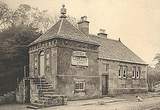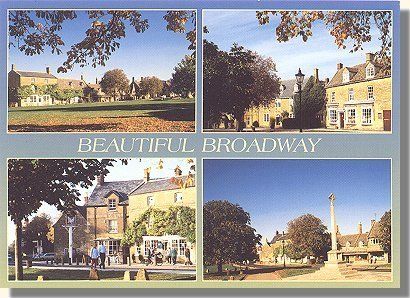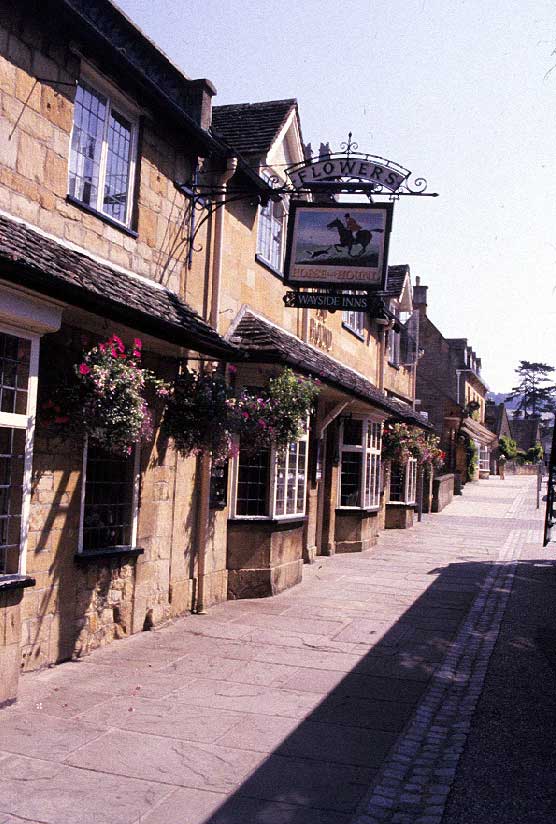Broadway,
The Cotswolds,
England
jpg: Jeff
Jarrett
Jpg: andrew.cmu.edu
jpg: Jeff
Jarrett
Broadway, located
80 miles northwest
from London central, was once part of the Worcester to London coaching
route. The trip by coach took approximately 16 hours, and from about
1600
onward, Broadway became a critical stop for changing horses
before
the long accent just out of town. At its height during that period, the
village had 33 public houses and was a relatively prosperous little
community
serving one industry.
With the advent of
the railway and
an opening of a line nearby in Evesham by 1860, the purpose of Broadway
as a resting spot for travelers became unnecessary and the community
fell
back into a sleepy obscurity.

Fish
Inn
c.
late 1800s
Though the country
and world of commerce
had essentially forgotten it, by the 1880's a small band of American
artists
headed by Francis
Davis Millet, rediscovered this quaint reflection of long ago
country
village.
What is there to do in
Broadway?
Well, even today the honest answer is, according to Walter Wentz [3]
(who happens to be another expatriate American in love with the place)
"not much." It was this exact proposition that struck Frank Millet just
fine.
Henry James said:
"Broadway and much
of the land about it are in short the perfection of the old English
rural
tradition." The village's' "broad way" (actually called High Street)
lined
with red chestnut trees, reflects the varied architectural history from
grand Georgian buildings to ones of humbler though quaint beginnings
that
even reaches back, in places, to the Romans. There was Abbots Grange
(pretty
much abandoned and deteriorating when Millet arrived) dating to the
14th
century, the oldest domestic building in the village and one of the
oldest
in the country. There are Tudor Houses dating from 1660's and along
with
parts of the Lygon Arms Hotel and St. Eadburgha’s Church which has been
a place of worship for almost 1000 years.
For this band of
creative artists,
the people were friendly, the rent was inexpensive, the Cotswolds
countryside offered countless lush day-walks from nowhere to nowhere
and
nothing but gorgeous scenery of a "very old English village, lying
among
its meadows and hedges, in the very heart of the country, in a hollow
of
the green hills . . . .[to see the artists'] affection for the
wide,
long, grass-bordered vista of brownish gray cottages, thatched,
latticed,
mottled, mended, ivied, immemorial [through their work]." (Henry
James) Finding
something
to do and things to entertain themselves in a place with "not much"
seemed
just about perfect - if not downright heaven -- a recluse from the
hectic
pace of London in which to relax, paint, take walks, read books, write
stories, play croquet in the afternoon, and create their own music
after
dark.
To Frank
Millet, the more the merrier, and come they did. Besides Frank, his
wife, their young children and his sister, there was Frank's good
friend Edwin
Austin Abbey whom he had known for a long time. Abbey brought along
John Singer Sargent. They invited their fellow illustrators from
Harper's
Magazine: Edwin Blashfield, Alfred
Parsons who shared his home with the Millet's in London and
partnered
with a studio with Abbey; and Frederick
Barnard who brought his wife and children and set up residence in a
house nearby. There were writers such as Edmund
Gosse with wife and children, along with Henry
James all taking up rooms and when those filled up they just
spilled
over into the near empty Lygon Arms hotel just
across
the green or in other houses as Frederick had done. As time went on
only
more people came with everything revolving around Frank Millet's home.
The mood was
festive, teaming with
intelligent, highly talented, gifted people and children playing,
running
under foot, laughing - can you imagine?
Abbey wrote:
"We have music until the house won't stand it. Sargent is going
elaborately
through Wager's trilogy, recitatives and all: there are moments when it
doesn't seem as if it could be meant for music, but I dare say it is.
I've
been painting a head. Sargent does it better than I do and quicker, but
then he's younger . . . . Miss Gertrude Giswold sings to us like an
angle
. . . . We really do have a gay summer, pretending to work and
sometimes
working (for there are numberless places with
easels
in them to hide away in -- if you really do want to work --
until
four and then tennis until dinner time, and after dinner, dancing and
music
and various cheering games in the studio, but mostly dancing."[4]
Edmund
Gosse
wrote: "Nothing we do scandalizes the villagers. Fred Barnard, with an
enormous stage slouch hat over his shoulders, chases one of the
Americans
down the village street, the man chased screaming all the time and
trying
to escape up lamp-posts and down wells. Not a villager smiled . . . .
Whatever
we do or say or wear or sing they only say 'Them Americans is out
again'."[5]
Such would be the
setting for Sargent's Carnation,
Lily, Lily, Rose.
John
Singer Sargent

Carnation,
Lily, Lily, Rose
1885-86
Today, the village
has changed little
since the colony of artists were there. The people are still remarkably
friendly, but it's no longer the quaint secrete held by artists
in
hiding. That secrete is very much out, no thanks (in part) to
Henry
James for splashing it across the pages of Harper's Magazine to all of
America and the rest of the world; and Frank Millet for dragging anyone
out of London he could drag. The accommodations, you will find, are no
longer "inexpensive." The bohemian days, I'm afraid, are gone but the
charm
and beauty remains no less. The village now has a selection of gift
shops
and antique stores hidden within the existing architecture. Bill
Grant, an admirer of the place and writer, tells me that "Broadway
today is a bit of a contradiction, albeit a very pleasant one. There is
a number of upmarket galleries but I wouldn't exactly call it arty. It
has a hunt and a typical village pub next to the church but you can
also
buy cashmere in the High Street where it is not unusual to see both
Ferraris
and tractors."
Just outside the
village, at the
top of the long, steep escarpment is the Broadway
Tower, from which there is commanding view of the countryside.
The JSS Gallery's
own Wendy and Gordon
Hawksley just recently visited Broadway and captured a number of
pictures
for us.
From: Wendy
& Gordon Hawksley
<g w @
whawksley. fsnet.
co. uk>
Date: Tue, 25 Mar
2003
We can honestly say
that the Cotswolds
and, in particular the North Cotswolds, is our favourite place in this
country. Broadway and Chipping Campden have a wonderful feel about them
due, in no small way, to the famous yellow / honey coloured Cotswold
stone
buildings and walls which are often covered in lichen. It even looks
good
when its raining! The Cotswolds generally exude a safe and unhurried
feel
with little / no graffiti or litter to spoil them. These places very
much
represent quietly prosperous Middle England.
Broadway is crammed
with some of
the country's best art galleries, which can be all too tempting at
times!
(We should add though that the prices are usually well out of our
league!).
Haynes Fine Art is at Picton House (shown in
photo
6). We understand that Haynes spent around £250,000 on
renovating
Picton House a few years ago and must say that they appear to have done
a wonderful job. Another gallery of interest is the John Noot Galleries
which are actually located in three places in Broadway, the smallest of
which is probably the one at the famous Lygon
Arms
hotel on the High Street. The Lygon is probably one of the best
country
house hotels in England. It is a beautiful building which has a top
restaurant
with a instrels gallery, a small but lovely garden (with croquet lawn)
and, for those who want to arrive in style, a helipad! If, like ours,
your
purse strings don't quite stretch that far [the smallest room starts at
£119 per night with a bathroom adjacent -- suites starting at
£329
per night], you will get there by car and park in their car park at the
back of the building, look longingly around the hotel grounds, then go
and have a meal at Oliver's which is a brasserie attached to the hotel
(pre booking is usually vital at the weekends). We were very tempted by
one or two paintings at the Priory Gallery at Forge House on the High
Street.
It has a small but rather good collection of Modern British works.
However,
currently, our favourite gallery is the Broadway Modern which is nearly
opposite Farnham House on the left side of the High Street. It has a
fantastic
collection of modern art, sculpture, furniture etc and the prices are
usually
reasonably accessible. We should add that we don't recommend that you
visit
on any public holidays as there are far too many tourists which tends
to
spoil the feel of it all.
- With our best
wishes,
Wendy & Gordon
Note
Special thanks to
Wendy & Gordon
Hawksley, of Sheffield England, wonderful friends
of the JSS Gallery, for taking pictures of Broadway specifically
for
the JSS Gallery.
2) Henry James, "Our
Artist in
Europe"; Harper's New Monthly Magazine, Volume LXXIX, Page
50-66;
June to November 1889 -- also featured on the net at Cornell
Making of America

3) Walter Wentz, "An
American in
Broadway"; www.cotswolds.info, no date, (http://www.cotswolds.info
/monthly-diary.htm#americantop)

4) E.V. Lucas, "E.A.
Abbey"; Scribners
(NY) and Methuen (London), 1921, p. 152

5) Stanley Olson, John
Singer Sargent;
His Portrait, St. Martin's Press, NY, 1986, pp. 125-126
Also referenced
The Hon. Evan
Charteris, K.C. "John
Sargent", Benjamin Blom, Inc. Publishers, New York, 1972, P. 72

|






